
The Province of Upper Canada was a part of British Canada established in 1791 by the Kingdom of Great Britain, to govern the central third of the lands in British North America, formerly part of the Province of Quebec since 1763. Upper Canada included all of modern-day Southern Ontario and all those areas of Northern Ontario in the Pays d'en Haut which had formed part of New France, essentially the watersheds of the Ottawa River or Lakes Huron and Superior, excluding any lands within the watershed of Hudson Bay. The "upper" prefix in the name reflects its geographic position along the Great Lakes, mostly above the headwaters of the Saint Lawrence River, contrasted with Lower Canada to the northeast.

Archibald Acheson, 2nd Earl of Gosford,, styled The Honourable Archibald Acheson from 1790 to 1806 and Lord Acheson from 1806 to 1807, was a British politician who served as Lieutenant-Governor of Lower Canada and Governor General of British North America in the 19th century.

The Upper Canada Rebellion was an insurrection against the oligarchic government of the British colony of Upper Canada in December 1837. While public grievances had existed for years, it was the rebellion in Lower Canada, which started the previous month, that emboldened rebels in Upper Canada to revolt.

The Family Compact was a small closed group of men who exercised most of the political, economic and judicial power in Upper Canada from the 1810s to the 1840s. It was the Upper Canadian equivalent of the Château Clique in Lower Canada. It was noted for its conservatism and opposition to democracy.

The Attorney General of Ontario is the chief legal adviser to His Majesty the King in Right of Ontario and, by extension, the Government of Ontario. The Attorney General is a senior member of the Executive Council of Ontario and oversees the Ministry of the Attorney General – the department responsible for the oversight of the justice system in the province of Ontario. The Attorney General is an elected Member of Provincial Parliament who is appointed by the Lieutenant Governor of Ontario on the constitutional advice of the Premier of Ontario. The Ministry is the largest justice system in Canada and one of the largest in North America.

Sir Dominick Daly was a British colonial public servant and administrator during the 19th century, who held positions in British North America, Tobago and South Australia.
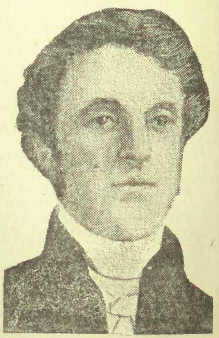
Henry Sherwood, was a lawyer and Tory politician in the Province of Canada. He was involved in provincial and municipal politics. Born into a Loyalist family in Brockville in Augusta Township, Upper Canada, he studied law and was called to the bar of Upper Canada in 1828. In 1838, he was appointed Queen's Counsel. Sherwood was part of the Family Compact, the inter-connected families of strong British and Loyalist sympathies which dominated the government of Upper Canada in the early years of the 19th century
Christopher Alexander Hagerman, was a Canadian militia officer, lawyer, administrator, politician and judge.
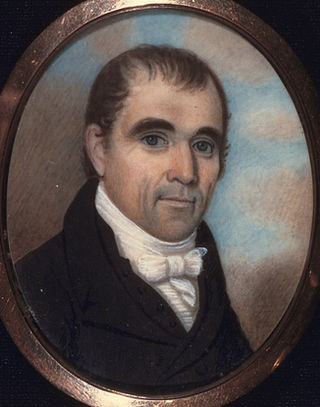
Robert Thorpe was a judge and political figure in Upper Canada and was later chief justice of Sierra Leone.

Sir John Beverley Robinson, 1st Baronet, was a lawyer, judge and political figure in Upper Canada. He was considered the leader of the Family Compact, a group of families which effectively controlled the early government of Upper Canada.
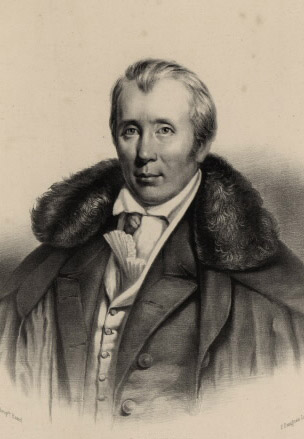
William Warren Baldwin was a medical doctor, businessman, lawyer, judge, architect and reform politician in Upper Canada. He, and his son Robert Baldwin, are recognized for having introduced the concept of "responsible government", the principle of cabinet rule on which Canadian democracy is based.

Charles Richard Ogden, was a Joint Premier of the Province of Canada for Canada East from 1841 to 1842 with William Henry Draper PM for Canada West. Odgen was a member of the Château Clique, the group of English-speaking officials who supported the Governor General, appointed by the British government. Trained as a lawyer, he developed a lucrative practice at Trois-Rivières and then Montreal. He had a lengthy career as a member of the Legislative Assembly of Lower Canada.
General Thomas Carleton was an Irish-born British Army officer who was promoted to colonel during the American Revolutionary War after relieving the siege of Quebec in 1776. After the war, he was appointed as Lieutenant-Governor of New Brunswick, and supervised the resettlement of Loyalists from the United States in the province. He held this position until his death, although he was absent in England for the last fourteen years of his tenure, refusing orders to return in a dispute about seniority.
Henry John Boulton, was a lawyer and political figure in Upper Canada and the Province of Canada, as well as Chief Justice of Newfoundland.
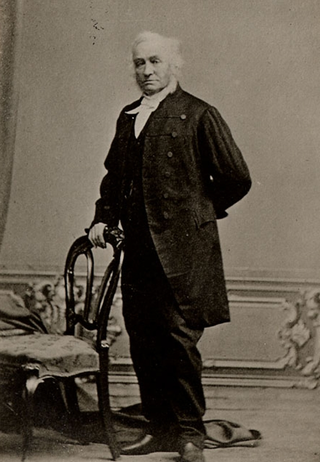
Edward Hale, D.C.L. was a Quebec businessman and political figure. He was Chancellor of Bishop's University and a significant figure to Bishop's College School.
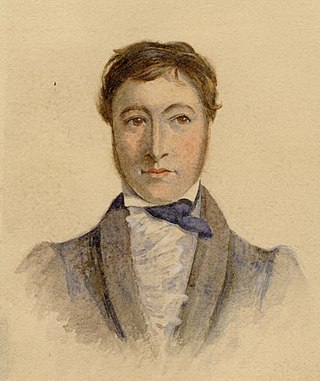
John Henry Dunn was a public official and businessman in Upper Canada, who later entered politics in the Province of Canada. Born on Saint Helena of English parents, he came to Upper Canada as a young man to take up the position of Receiver General for Upper Canada, a position he held from 1820 to 1841.

Sir James Stuart, 1st Baronet of Oxford was a lawyer, judge, and political figure in Lower Canada.
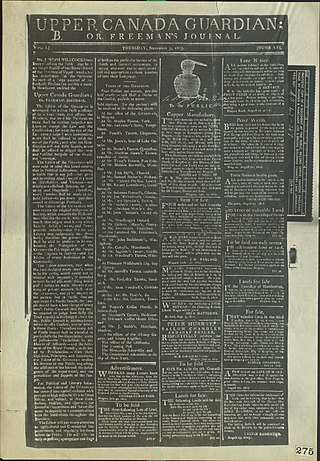
The Upper Canada Guardian; or Freeman's Journal was one of the first opposition papers in 19th century Upper Canada. Its publisher and editor Joseph Willcocks established it after moving to Niagara in 1807 to combat arbitrary power, oppressive land laws, and ultimately create liberty in the province. Willcocks claimed that the Guardian was meant: “to disseminate the principles of political truth, check the progress of inordinate power, and keep alive the sacred flame of a just and rational liberty.” In 1809, Judge William Dummer Powell complained of its widespread popularity and the fact that it was in nearly every household. It was a four-page paper published between July 24, 1807, and June 9, 1812 and printed in with the roman cursive “f” representing the English long "s". The Upper Canada Guardian came to an end when Willcocks sold its printing press to Richard Hatt in June 1812 for $1,600.

Formally known as "His Majesty's Council of Nova Scotia", the Nova Scotia Council (1720–1838) was the original British administrative, legislative and judicial body in Nova Scotia. The Nova Scotia Council was also known as the Annapolis Council and the Halifax Council. After 1749, when the judicial courts were established, the Nova Scotia Council was limited to administrative and legislative powers.

A series of parliamentary reports describe the scope of the problem of debt in Upper Canada; as early as 1827, the eleven district jails in the province had a capacity of 298 cells, of which 264 were occupied, 159 by debtors. In the Home District, 379 of 943 prisoners between 1833 and 1835 were being held for debt. Over the province as a whole, 48% or 2304 of 4726 prisoners were being held in jail for debt in 1836. The number of debtors jailed was the result of both widespread poverty, and the small amounts for which debtors could be indefinitely detained.